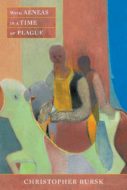 Christopher Bursk
Christopher Bursk
With Aeneas in a Time of Plague
Ragged Sky Press
Reviewer: Vivian Wagner
With Aeneas in a Time of Plague, Christopher Bursk’s last collection, is a book about loss and death, hope and renewal. It is, in many ways, a pandemic book, published in the midst of Covid and always on some level about humanity’s struggle to find its way out of the constant sense of doom and foreboding created by the virus.
The book is also, however, about the misfortunes that we as humans face more broadly, in all eras and stages of life, and about how literature and storytelling can help us to navigate and survive all manner of trying times.
Virgil’s Aeneid serves as inspiration for the collection, providing structure and shape to individual poems and to the book as a whole. The collection progresses from the poet’s early introduction to the Aeneid by his father to his interactions with the text and other literature as a teenager and adult, and finally to his relationship with some of these same stories and images in old age. In this manner, the book is a sort of memoir, demonstrating how literature and life interact and, at some point, become nearly indistinguishable.
Many of the poems in this collection are about survival, beginning with the first, “At the Cave of the Sibyl of Cumae.” It opens with a young boy expressing a desire to survive ever-more-difficult challenges:
When I was six, I told myself
if I could just survive first grade
I could probably survive anything.
Then my dog ran back into the yard
with my friend’s cat in its mouth …
The poem progresses through a series of difficulties, from the speaker visiting his mother in the hospital to his worrying over a young child’s impending operation. The final stanza shows how the Aeneid gave him strength through all of these challenges, even as it never offers false hope:
If only I could be that Aeneas
who proclaims in Book VI of the Aeneid,
No ordeal, O Sibyl, no new test can dismay me,
for I have fore-seen and fore-suffered all.
But I have read Book VII
and know what comes next.
The Aeneid, which itself narrates the challenges faced by a wandering Aeneas, gives the speaker a sense of structure and purpose and an understanding that those challenges are never-ending, and are in fact the stuff of life itself. There’s a grim but somewhat hopeful determination in that realization, however. A sense of camaraderie also emerges, as the speaker is not traveling his road alone but always with the imagined companionship of Aeneas.
In this early section, the collection demonstrates how firmly grounded it is in the reality of the contemporary pandemic, as in the poem “A Prayer for Pallas”:
When I first typed these lines,
the plague had already claimed 240 in our county,
865 in our state,
77, 212 nationwide
but now the virus is revising its figures
to over 507,269 in the country …
The virus, as a kind of author, revises its figures, altering the story even as it writes it. The speaker, in turn, is a reader of the virus’s story, a witness to its evolving disaster. The numbers in this poem, too, reveal a speaker who’s interested in specific details, and in the way those details populate and flesh out a larger narrative of suffering, death, and loss.
The poem then ties this current pandemic to deaths in the Aeneid:
. . . 53,392 in the Italy
to which the son of Anchises voyaged
and where, having scraped Pallas off the battlefield—
that prayed-for son, that unlucky lad—
Aeneas made possible Rome and its Golden Age.
The contemporary dead echo the literary dead, with both intermingling and becoming part of one narrative.
Similarly, “The Plague in Early Spring” tells of the increasing disintegration wrought by the pandemic, week-by-week:
The first week in the first year of the plague,
when we told ourselves there was no plague,
the flowers were more than willing
to confirm our opinion.
Gradually, however, the speaker of this poem comes to realize that there’s no end in sight to this pandemic or to the loss it engenders:
The sixth week of the plague
we started hating tulips and daffodils
for flaunting themselves just outside our windows
as if there were no such thing as a plague.
These flowers, which could be a sign of hope for the pandemic-embattled speaker, seem to be mocking him, even as they suggest a world outside humanity’s frailty that might actually have something to say about survival.
In “Turning to Page 194 in the Very Same Copy of the Aeneid from Which My Father Read to My Brother, 9, and Me, 5,” we learn that there is a reason the speaker is interested in the Aeneid: his father read the poem to him and his brother. It becomes clear that the Aeneid is not just a cultural touchstone, but also a deeply personal one:
It was young Ascanius’s first war.
Bring back my father, let me see him.
What can we fear when he’s with us?
Father’s return alone can save us—
By introducing his sons to this text, the father gave them stories that would help them to make sense of the world. This poem invokes the loss of the father and the realization that he gave his sons a vital gift. Bursk’s collection is, in many ways, a tribute to that father, who understood that these stories would help them endure their own journeys.
The poems progress through the trials and tribulations of a life, always mediated by the Aeneid and other literary texts. In a section entitled “Reading the Aeneid at Seventy-Six,” the poet explores what the text has to say to him in old age. These poems illustrate a life lived in and through books, words, and stories, showing how literature can provide solace and connection even at life’s most difficult moments.
“A Quiz for Those Who May Have Found a Father’s Suicide Note,” for instance, looks both straight and askance at its subject, opening as follows
Match the lines to its author/translator. Your choices:
Father
Dryden
Seamus Heaney
Virgil
Sarah Ruden
David Ferry
Son
The speaker’s personal life here is intertwined with his literary one, and the literary references provide the kind of distance he needs to tell an unbearable tale: “Beyond this but not far, and widely spread, / Are the Fields of Lamentation. The speaker can only tell this story of a father’s suicide through literary references, which provide him and the reader with the breathing room necessary to feel and understand otherwise unspeakable grief.
The collection’s final poem, “The Procession to the Palace of King Neptune,” ends with a description of the interconnectivity and compassion to be found in literature:
… all of us have been raised from the dead
but that doesn’t mean
we don’t need a little help still keeping our balance
on the golden steps
in the marble halls to which Endymion had led us,
especially if we were singing,
and by now who of us isn’t singing?
The speaker here, close to death or beyond it, still needs help, just as he has throughout this collection. And, as it always has, that aid comes in the form of the steadying hand of literature, guiding him and us up one golden step—one pandemic, one loss, one death—after another.

